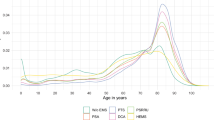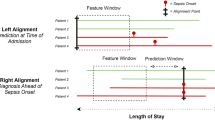Abstract
This retrospective study assessed the effectiveness and impact of implementing a Modified Early Warning System (MEWS) and Rapid Response Team (RRT) for inpatients admitted to the general ward (GW) of a medical center. This study included all inpatients who stayed in GWs from Jan. 2017 to Feb. 2022. We divided inpatients into GWnon-MEWS and GWMEWS groups according to MEWS and RRT implementation in Aug. 2019. The primary outcome, unexpected deterioration, was defined by unplanned admission to intensive care units. We defined the detection performance and effectiveness of MEWS according to if a warning occurred within 24 h before the unplanned ICU admission. There were 129,039 inpatients included in this study, comprising 58,106 GWnon-MEWS and 71,023 GWMEWS. The numbers of inpatients who underwent an unplanned ICU admission in GWnon-MEWS and GWMEWS were 488 (.84%) and 468 (.66%), respectively, indicating that the implementation significantly reduced unexpected deterioration (p < .0001). Besides, 1,551,525 times MEWS assessments were executed for the GWMEWS. The sensitivity, specificity, positive predicted value, and negative predicted value of the MEWS were 29.9%, 98.7%, 7.09%, and 99.76%, respectively. A total of 1,568 warning signs accurately occurred within the 24 h before an unplanned ICU admission. Among them, 428 (27.3%) met the criteria for automatically calling RRT, and 1,140 signs necessitated the nursing staff to decide if they needed to call RRT. Implementing MEWS and RRT increases nursing staff's monitoring and interventions and reduces unplanned ICU admissions.





Similar content being viewed by others
Data availability
The datasets generated during and/or analyzed during the current study are available from the corresponding author on reasonable request.
References
Franklin C, Mathew J (1994) Developing strategies to prevent inhospital cardiac arrest: analyzing responses of physicians and nurses in the hours before the event. Crit Care Med 22:244-247.
Schein RM, Hazday N, Pena M, Ruben BH, Sprung CL (1990) Clinical antecedents to in-hospital cardiopulmonary arrest. Chest 98:1388-1392.
Buist MD, Moore GE, Bernard SA, Waxman BP, Anderson JN, Nguyen TV (2002) Effects of a medical emergency team on reduction of incidence of and mortality from unexpected cardiac arrests in hospital: preliminary study. BMJ 324:387-390. https://doi.org/10.1136/bmj.324.7334.387
Kenward G, Castle N, Hodgetts T, Shaikh L (2004) Evaluation of a medical emergency team one year after implementation. Resuscitation 61:257-263.
Bellomo R, Goldsmith D, Uchino S, Buckmaster J, Hart GK, Opdam H, Silvester W, Doolan L, Gutteridge G (2003) A prospective before-and-after trial of a medical emergency team. Med J Aust 179:283-287. https://doi.org/10.5694/j.1326-5377.2003.tb05548.x
Maharaj R, Raffaele I, Wendon J (2015) Rapid response systems: a systematic review and meta-analysis. Crit Care 19:254. https://doi.org/10.1186/s13054-015-0973-y
Jung B, Daurat A, De Jong A, Chanques G, Mahul M, Monnin M, Molinari N, Jaber S (2016) Rapid response team and hospital mortality in hospitalized patients. Intensive Care Med 42:494-504. https://doi.org/10.1007/s00134-016-4254-2
Jones D, Moran J, Winters B, Welch J (2013) The rapid response system and end-of-life care. Curr Opin Crit Care 19:616-623. https://doi.org/10.1097/MCC.0b013e3283636be2
Stenhouse C, Coates S, Tivey M, Allsop P, Parker T (2000) Prospective evaluation of a modified Early Warning Score to aid earlier detection of patients developing critical illness on a general surgical ward. British Journal of Anaesthesia 84:663P. https://doi.org/10.1093/bja/84.5.663
Subbe CP, Kruger M, Rutherford P, Gemmel L (2001) Validation of a modified Early Warning Score in medical admissions. QJM 94:521-526. https://doi.org/10.1093/qjmed/94.10.521
Smith GB, Prytherch DR, Meredith P, Schmidt PE, Featherstone PI (2013) The ability of the National Early Warning Score (NEWS) to discriminate patients at risk of early cardiac arrest, unanticipated intensive care unit admission, and death. Resuscitation 84:465-470. https://doi.org/10.1016/j.resuscitation.2012.12.016
Alves Silva LM, Moroço DM, Pintya JP, Miranda CH (2021) Clinical impact of implementing a rapid-response team based on the Modified Early Warning Score in wards that offer emergency department support. PLoS One 16:e0259577. https://doi.org/10.1371/journal.pone.0259577
Mahmoodpoor A, Sanaie S, Saghaleini SH, Ostadi Z, Hosseini MS, Sheshgelani N, Vahedian-Azimi A, Samim A, Rahimi-Bashar F (2022) Prognostic value of National Early Warning Score and Modified Early Warning Score on intensive care unit readmission and mortality: A prospective observational study. Front Med (Lausanne) 9:938005. https://doi.org/10.3389/fmed.2022.938005
Ko RE, Kwon O, Cho KJ, Lee YJ, Kwon JM, Park J, Kim JS, Kim AJ, Jo YH, Lee Y et al (2022) Quick Sequential Organ Failure Assessment Score and the Modified Early Warning Score for Predicting Clinical Deterioration in General Ward Patients Regardless of Suspected Infection. J Korean Med Sci 37:e122. https://doi.org/10.3346/jkms.2022.37.e122
van Mourik N, Oomen JJ, van Vught LA, Biemond BJ, van den Bergh WM, Blijlevens NMA, Vlaar APJ, Müller MCA (2023) The predictive value of the modified early warning score for admission to the intensive care unit in patients with a hematologic malignancy - A multicenter observational study. Intensive Crit Care Nurs 79:103486. https://doi.org/10.1016/j.iccn.2023.103486
Allarakia J, Felemban T, Alghamdi A, Ashi A, Al Talhi YM, Alsahafi A, Alamri A, Aldabbagh M (2023) Modified Early Warning Score (MEWS) as a predictor of intensive care unit admission in cancer patient on chemotherapy with positive blood culture: A retrospective cohort study. J Infect Public Health 16:865-869. https://doi.org/10.1016/j.jiph.2023.03.012
Wang L, Lv Q, Zhang X, Jiang B, Liu E, Xiao C, Yu X, Yang C, Chen L (2020) The utility of MEWS for predicting the mortality in the elderly adults with COVID-19: a retrospective cohort study with comparison to other predictive clinical scores. PeerJ 8:e10018. https://doi.org/10.7717/peerj.10018
Al-Salman J, Sanad Salem Alsabea A, Alkhawaja S, Al Balooshi AM, Alalawi M, Abdulkarim Ebrahim B, Hasan Zainaldeen J, Al Sayyad AS (2023) Evaluation of an adjusted MEWS (Modified Early Warning Score) for COVID-19 patients to identify risk of ICU admission or death in the Kingdom of Bahrain. J Infect Public Health 16:1773-1777. https://doi.org/10.1016/j.jiph.2023.09.002
Barnett WR, Radhakrishnan M, Macko J, Hinch BT, Altorok N, Assaly R (2021) Initial MEWS score to predict ICU admission or transfer of hospitalized patients with COVID-19: A retrospective study. J Infect 82:282-327. https://doi.org/10.1016/j.jinf.2020.08.047
Na SJ, Ko RE, Ko MG, Jeon K (2021) Automated alert and activation of medical emergency team using early warning score. J Intensive Care 9:73. https://doi.org/10.1186/s40560-021-00588-y
Heller AR, Mees ST, Lauterwald B, Reeps C, Koch T, Weitz J (2020) Detection of Deteriorating Patients on Surgical Wards Outside the ICU by an Automated MEWS-Based Early Warning System With Paging Functionality. Ann Surg 271:100-105. https://doi.org/10.1097/SLA.0000000000002830
Haegdorens F, Monsieurs KG, De Meester K, Van Bogaert P (2020) The optimal threshold for prompt clinical review: An external validation study of the national early warning score. J Clin Nurs 29:4594-4603. https://doi.org/10.1111/jocn.15493
Romero-Brufau S, Huddleston JM, Naessens JM, Johnson MG, Hickman J, Morlan BW, Jensen JB, Caples SM, Elmer JL, Schmidt JA et al (2014) Widely used track and trigger scores: are they ready for automation in practice? Resuscitation 85:549-552. https://doi.org/10.1016/j.resuscitation.2013.12.017
Braun EJ, Singh S, Penlesky AC, Strong EA, Holt JM, Fletcher KE, Stadler ME, Nattinger AB, Crotty BH (2022) Nursing implications of an early warning system implemented to reduce adverse events: a qualitative study. BMJ Qual Saf 31:716-724. https://doi.org/10.1136/bmjqs-2021-014498
Nishijima I, Oyadomari S, Maedomari S, Toma R, Igei C, Kobata S, Koyama J, Tomori R, Kawamitsu N, Yamamoto Y et al (2016) Use of a modified early warning score system to reduce the rate of in-hospital cardiac arrest. J Intensive Care 4:12. https://doi.org/10.1186/s13054-016-1208-6
Hatlem T, Jones C, Woodard EK (2011) Reducing mortality and avoiding preventable ICU utilization: analysis of a successful rapid response program using APR DRGs. J Healthc Qual 33:7-16. https://doi.org/10.1111/j.1945-1474.2011.00084.x
Dewar ZE, Kirchner HL, Rittenberger JC (2020) Risk factors for unplanned ICU admission after emergency department holding orders. J Am Coll Emerg Physicians Open 1:1623-1629. https://doi.org/10.1002/emp2.12203
Shiloh AL, Ari Eisen L, Savel RH (2015) The unplanned intensive care unit admission. J Crit Care 30:419-420. https://doi.org/10.1016/j.jcrc.2014.12.010
Glass G, Hartka TR, Keim-Malpass J, Enfield KB, Clark MT (2021) Dynamic data in the ED predict requirement for ICU transfer following acute care admission. J Clin Monit Comput 35:515-523. https://doi.org/10.1007/s10877-020-00500-3
Delgado MK, Liu V, Pines JM, Kipnis P, Gardner MN, Escobar GJ (2013) Risk factors for unplanned transfer to intensive care within 24 hours of admission from the emergency department in an integrated healthcare system. J Hosp Med 8:13-19. https://doi.org/10.1002/jhm.1979
Author information
Authors and Affiliations
Contributions
WJ Liaw, TJ Wu, and WC Shen conceived and designed the study. LH Huang, CS Chen, IC Lin, and YH Liao collected and interpreted the clinical data. YL Liao and WC Shen performed the statistical analysis. WJ Liaw, WC Shen, YH Liao, and MC Tsai wrote the manuscript. Finally, WJ Liaw and WC Shen made critical revisions.
Corresponding author
Ethics declarations
Informed consent
This study was approved by the Institutional Review Board of Chung Shan Medical University Hospital (Date: Feb. 8, 2023/No.CS1-22196). Written, informed consent was waived for this retrospective analysis.
Competing interests
The authors declare no conflict of interest.
Additional information
Publisher's Note
Springer Nature remains neutral with regard to jurisdictional claims in published maps and institutional affiliations.
Supplementary Information
Below is the link to the electronic supplementary material.
Rights and permissions
Springer Nature or its licensor (e.g. a society or other partner) holds exclusive rights to this article under a publishing agreement with the author(s) or other rightsholder(s); author self-archiving of the accepted manuscript version of this article is solely governed by the terms of such publishing agreement and applicable law.
About this article
Cite this article
Liaw, WJ., Wu, TJ., Huang, LH. et al. Effectiveness of Implementing Modified Early Warning System and Rapid Response Team for General Ward Inpatients. J Med Syst 48, 35 (2024). https://doi.org/10.1007/s10916-024-02046-2
Received:
Accepted:
Published:
DOI: https://doi.org/10.1007/s10916-024-02046-2




